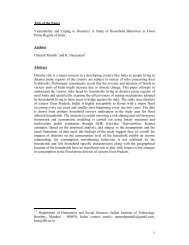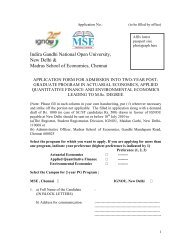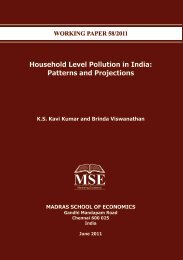A Macro-Fiscal Modeling Framework for Forecasting and Policy ...
A Macro-Fiscal Modeling Framework for Forecasting and Policy ...
A Macro-Fiscal Modeling Framework for Forecasting and Policy ...
You also want an ePaper? Increase the reach of your titles
YUMPU automatically turns print PDFs into web optimized ePapers that Google loves.
carry <strong>for</strong>ward the analysis of policy issues (simulations) initiated by the Second Phase<br />
model builders.<br />
(d)<br />
Fourth Phase: Models Prepared in the Nineties <strong>and</strong> Later<br />
A few popular models in this category include Anjaneyulu (1993), Bhattacharya <strong>and</strong> Guha<br />
(1992), Bhattacharya, Barman <strong>and</strong> Nag (1994), Chakrabarty <strong>and</strong> Joshi (1994), Rangarajan<br />
<strong>and</strong> Mohanty (1997), Klein <strong>and</strong> Palanivel (1999), <strong>and</strong> Bhattacharya <strong>and</strong> Kar (2007). They all<br />
address issues relevant to new policy regime (after re<strong>for</strong>m) <strong>and</strong> carry out many “what if”<br />
policy scenario simulations. Obviously, these models are larger in size, highly disaggregated<br />
<strong>and</strong> considering inter-links <strong>and</strong> trade-offs between sectors.<br />
Since many of the modelling exercises in India have been the result of ef<strong>for</strong>ts of<br />
individual researchers, none of them were maintained <strong>and</strong> serviced on a sustained basis <strong>for</strong><br />
policy analysis <strong>and</strong> <strong>for</strong>ecasting. There<strong>for</strong>e, attempts have been made to build <strong>and</strong> maintain<br />
comprehensive models incorporating complexities by reputed institutions on an ongoing<br />
basis <strong>and</strong> are regularly used <strong>for</strong> <strong>for</strong>ecasting. They have a number of advantages over the<br />
one-time models as they regularly add new in<strong>for</strong>mation by the way of data, policy changes<br />
<strong>and</strong> developments in theory <strong>and</strong> estimation techniques. An ef<strong>for</strong>t in this direction was<br />
initiated jointly by the Institute of Economic Growth (IEG) <strong>and</strong> Delhi School of Economics<br />
(DSE) in the early 1990s. At present the NCAER model, the IEG model <strong>and</strong> the DSE model<br />
are present.<br />
A large number of models covering the period at least until the eighties were<br />
based on estimates where proper testing of unit roots <strong>and</strong> stationarity of series was not<br />
undertaken. Even now, very few structural models have been specified <strong>and</strong> estimated<br />
using co-integration <strong>and</strong> error correction mechanisms if the relevant series are<br />
considered difference-stationary. Similarly, a comprehensive analysis of the structural<br />
breaks <strong>and</strong> the impact of economic re<strong>for</strong>ms has also not been an integral part of most of<br />
the Indian macro models. Some of the data constraints, however, are now less restrictive<br />
with many important macro time series stretching over 55 years. Most models that<br />
incorporated policy analysis also became methodologically dated because of inadequate<br />
specifications of the impact of expectations regarding policy changes on parameter<br />
values.<br />
New attempts at modeling the Indian economy should ensure that stationarity of<br />
variables is properly tested. If these are non-stationary then model specifications should<br />
recognize cointegration among variables <strong>and</strong> use error-correction models <strong>for</strong> <strong>for</strong>ecasting<br />
8



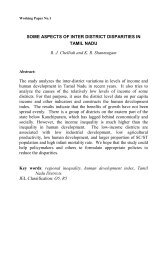
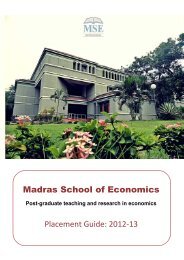
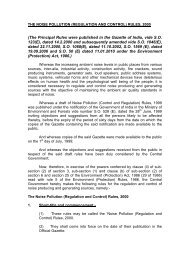
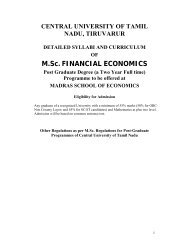
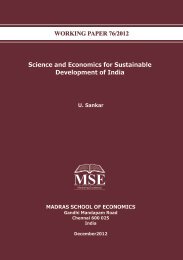
![Curriculum Vitae [pdf] - Madras School of Economics](https://img.yumpu.com/49878970/1/190x245/curriculum-vitae-pdf-madras-school-of-economics.jpg?quality=85)
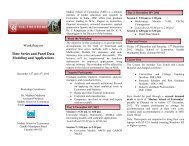
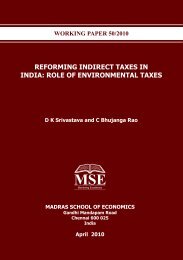
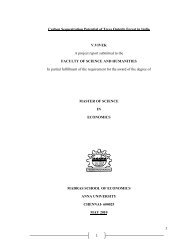
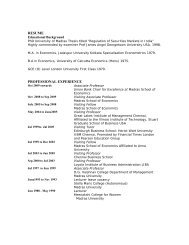
![Curriculum Vitae [pdf] - Madras School of Economics](https://img.yumpu.com/48715201/1/184x260/curriculum-vitae-pdf-madras-school-of-economics.jpg?quality=85)
